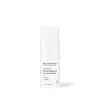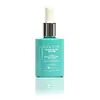What's inside
What's inside
 Key Ingredients
Key Ingredients

 Benefits
Benefits

 Concerns
Concerns

 Ingredients Side-by-side
Ingredients Side-by-side

Water
Skin ConditioningPrunus Armeniaca Kernel Oil
MaskingSimmondsia Chinensis Seed Oil
EmollientPolyacrylamide
C13-14 Isoparaffin
EmollientSodium Ascorbyl Phosphate
AntioxidantTetrahexyldecyl Ascorbate
AntioxidantSqualane
EmollientAlpha-Arbutin
AntioxidantSodium Hyaluronate
HumectantGlycine Soja Oil
EmollientLaureth-7
EmulsifyingCarbomer
Emulsion StabilisingPhenoxyethanol
PreservativeCitric Acid
BufferingEthylhexylglycerin
Skin ConditioningDisodium EDTA
Caffeine
Skin ConditioningRetinol
Skin ConditioningCamellia Sinensis Leaf Extract
AntimicrobialButylene Glycol
HumectantHelianthus Annuus Seed Oil
EmollientGlycerin
HumectantAlgae Extract
EmollientArnica Montana Flower Extract
MaskingHydrolyzed Silk
HumectantPhytonadione Epoxide
AstringentHydrolyzed Rice Protein
Skin ConditioningSuperoxide Dismutase
AntioxidantGlycine Soja Protein
EmulsifyingCaprylyl Glycol
EmollientCopper Tripeptide-1
Skin ConditioningEurya Japonica Extract
Skin ConditioningPalmitoyl Tetrapeptide-7
Skin ConditioningPalmitoyl Tripeptide-1
Skin ConditioningPolysorbate 20
EmulsifyingAcetyl Octapeptide-3
HumectantAcetyl Hexapeptide-8
HumectantPentapeptide-18
Skin ConditioningWater, Prunus Armeniaca Kernel Oil, Simmondsia Chinensis Seed Oil, Polyacrylamide, C13-14 Isoparaffin, Sodium Ascorbyl Phosphate, Tetrahexyldecyl Ascorbate, Squalane, Alpha-Arbutin, Sodium Hyaluronate, Glycine Soja Oil, Laureth-7, Carbomer, Phenoxyethanol, Citric Acid, Ethylhexylglycerin, Disodium EDTA, Caffeine, Retinol, Camellia Sinensis Leaf Extract, Butylene Glycol, Helianthus Annuus Seed Oil, Glycerin, Algae Extract, Arnica Montana Flower Extract, Hydrolyzed Silk, Phytonadione Epoxide, Hydrolyzed Rice Protein, Superoxide Dismutase, Glycine Soja Protein, Caprylyl Glycol, Copper Tripeptide-1, Eurya Japonica Extract, Palmitoyl Tetrapeptide-7, Palmitoyl Tripeptide-1, Polysorbate 20, Acetyl Octapeptide-3, Acetyl Hexapeptide-8, Pentapeptide-18
Water
Skin ConditioningMethylpropanediol
SolventAscorbic Acid
AntioxidantPropylene Glycol
HumectantPolysorbate 20
EmulsifyingGlycerin
HumectantLaureth-23
CleansingKojic Acid
AntioxidantAlpha-Arbutin
AntioxidantAzelaic Acid
BufferingButylene Glycol
HumectantCamellia Sinensis Leaf Extract
AntimicrobialCitrus Aurantium Dulcis Peel Oil
MaskingDiethanolamine
BufferingEthoxydiglycol
HumectantEuterpe Oleracea Fruit Extract
Ferulic Acid
AntimicrobialGlutathione
Niacinamide
SmoothingPanthenol
Skin ConditioningPhenoxyethanol
PreservativeRetinyl Palmitate
Skin ConditioningSodium Hyaluronate
HumectantTocopherol
AntioxidantTriethanolamine
BufferingWater, Methylpropanediol, Ascorbic Acid, Propylene Glycol, Polysorbate 20, Glycerin, Laureth-23, Kojic Acid, Alpha-Arbutin, Azelaic Acid, Butylene Glycol, Camellia Sinensis Leaf Extract, Citrus Aurantium Dulcis Peel Oil, Diethanolamine, Ethoxydiglycol, Euterpe Oleracea Fruit Extract, Ferulic Acid, Glutathione, Niacinamide, Panthenol, Phenoxyethanol, Retinyl Palmitate, Sodium Hyaluronate, Tocopherol, Triethanolamine
 Reviews
Reviews

Ingredients Explained
These ingredients are found in both products.
Ingredients higher up in an ingredient list are typically present in a larger amount.
Alpha-Arbutin is made from hydroquinone and glucose. It may also be derived from the fermentation of soybeans.
This ingredient an antioxidant, meaning it helps protect your skin cells against damage.
Studies show this ingredient helps improve hyperpigmentation and fade discoloration.
Alpha-Arbutin may be used with other ingredients that help with hyperpigmentation. These ingredients include retinol, Vitamin C, niacinamide, and tranexamic acid.
Learn more about Alpha-ArbutinButylene Glycol (or BG) is used within cosmetic products for a few different reasons:
Overall, Butylene Glycol is a safe and well-rounded ingredient that works well with other ingredients.
Though this ingredient works well with most skin types, some people with sensitive skin may experience a reaction such as allergic rashes, closed comedones, or itchiness.
Learn more about Butylene GlycolCamellia Sinensis Leaf Extract is derived from the leaves of the tea plant. Black tea, green tea, and oolong tea are all harvested from this plant.
This ingredient has many skin benefits:
This ingredient contains polyphenols, a strong antioxidant. Antioxidants help fight off molecules that damage skin cells.
On top of that, the antioxidants in green tea neutralize free-radicals from the sun. This gives the skin some extra UV protection, but should not replace sunscreen.
Many components of tea have anti-inflammatory properties.
Polyphenols and L-theanine help soothe the skin and reduce irritation. The caffeine in Camellia Sinensis Leaf Extract helps calm inflamed blood vessels.
Other compounds found in tea include: Vitamin Bs, linoleic acid, magnesium, calcium, iron, and zinc.
Research has shown both drinking Camellia Sinensis Leaf Tea and applying it to the skin can help boost skin elasticity and hydration. Studies also show using tea extract may reduce sebum, or oil, production.
Learn more about Camellia Sinensis Leaf ExtractGlycerin is already naturally found in your skin. It helps moisturize and protect your skin.
A study from 2016 found glycerin to be more effective as a humectant than AHAs and hyaluronic acid.
As a humectant, it helps the skin stay hydrated by pulling moisture to your skin. The low molecular weight of glycerin allows it to pull moisture into the deeper layers of your skin.
Hydrated skin improves your skin barrier; Your skin barrier helps protect against irritants and bacteria.
Glycerin has also been found to have antimicrobial and antiviral properties. Due to these properties, glycerin is often used in wound and burn treatments.
In cosmetics, glycerin is usually derived from plants such as soybean or palm. However, it can also be sourced from animals, such as tallow or animal fat.
This ingredient is organic, colorless, odorless, and non-toxic.
Glycerin is the name for this ingredient in American English. British English uses Glycerol/Glycerine.
Learn more about GlycerinPhenoxyethanol is a preservative that has germicide, antimicrobial, and aromatic properties. Studies show that phenoxyethanol can prevent microbial growth. By itself, it has a scent that is similar to that of a rose.
It's often used in formulations along with Caprylyl Glycol to preserve the shelf life of products.
Polysorbate 20 is made by combining ethoxylation of sorbitan, ethylene oxide, and lauric acid. It is a mild cleansing agent, surfactant, and emulsifier.
As a surfactant, it helps collect dirt and oils for washing. Emulsifiers prevent oils and water from separating.
Polysorbate 20 also adds scent to a product. Since it is made using sorbitol, it has a sweet scent. Sorbitol can also be found in fruits such as apples and peaches.
The lauric acid used to create Polysorbate 20 is often derived from coconuts.
Polysorbate 20 may not be fungal acne safe.
Learn more about Polysorbate 20Sodium Hyaluronate is hyaluronic acid's salt form. It is commonly derived from the sodium salt of hyaluronic acid.
Like hyaluronic acid, it is great at holding water and acts as a humectant. This makes it a great skin hydrating ingredient.
Sodium Hyaluronate is naturally occurring in our bodies and is mostly found in eye fluid and joints.
These are some other common types of Hyaluronic Acid:
Learn more about Sodium HyaluronateWater. It's the most common cosmetic ingredient of all. You'll usually see it at the top of ingredient lists, meaning that it makes up the largest part of the product.
So why is it so popular? Water most often acts as a solvent - this means that it helps dissolve other ingredients into the formulation.
You'll also recognize water as that liquid we all need to stay alive. If you see this, drink a glass of water. Stay hydrated!
Learn more about Water